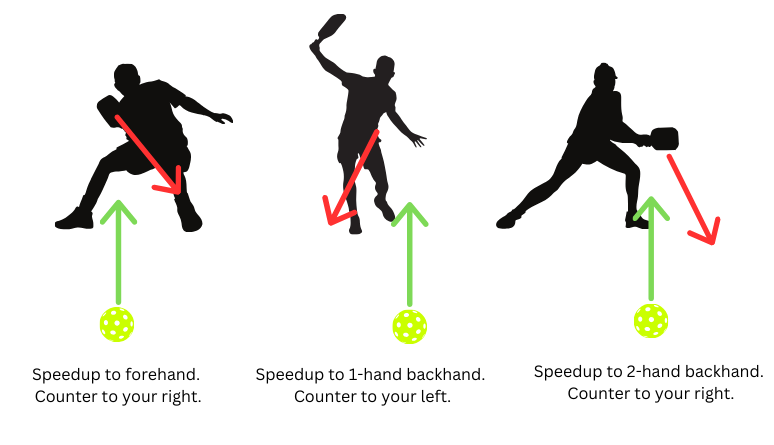
Busting out a speedup during a dinking rally used to win you the point in pickleball.
Not so much anymore. In fact, coaches now teach players to expect the speedup first instead of a dink so they are better prepared for a counter.
Extended dinking rallies, except at the top levels, just don’t happen anymore.
Sign up today for the most informative newsletter in pickleball from The Dink!
To win points at the kitchen, you need to develop better counters. This means you need faster hands. And how do we get faster hands?
Let’s discuss the “Triangle Rule.”
What is the Triangle Rule?
Content creator and pickleballer, Pickleburner, coined this “rule” in a video from September 2023. In it, he explains that when a ball is sped up, the counter typically leads to the ball being hit into a triangle pattern.
Essentially, if you speed the ball up to the person in front of you, and it’s successfully countered, then the ball isn’t likely going to come straight back, but its trajectory will be either to the left or right of you.
Here is how Pickleburner defines it:
“The Triangle Rule states that the ball path of the speedup and the counter always form a triangle. The angle of which you can predict based on the shot from which the counter comes and the quality of the speedup.”
We’ll get more into the prediction and quality of the speedup in a moment. First, we need to discuss why this matters.
Why it matters
As mentioned, a speedup rarely ends a rally. Instead, it typically initiates a hands battle. When hands battles begin, there is no time to think – it’s just pure reaction.
In a hands battle, your goal is to hit the ball back over the net and downward so that it’s either unhittable or causes your opponent to hit up on the ball, giving you an easy putaway.
Unfortunately, our hands can only be so quick. And, let’s be honest, most of us are not going to spend our free time doing hand and wrist exercises to make our hands quicker.
So, we have two options. Either we get a new paddle – one that’s lighter or covers more area, or we learn to anticipate where the ball is going. Who am I to stop you if you want to find a better paddle? Go for it.
If you want to learn how to anticipate better, that’s where the triangle rule can help.
Predict Where the Ball Will Go
According to Pickleburner, you can predict where the speedup counter will go based on where you place the speedup in relation to their body and paddle position.
If you hit a speedup to your opponent’s forehand, their counter is likely to go right of your body.
If you hit a speedup to your opponent’s one-handed backhand, it’ll go to the left of your body.
And, if you hit a speedup to your opponent’s two-handed backhand, it’ll go to the right of your body.
Here’s a graphic to help you visualize this more:

Like everything, this will not happen 100% of the time. According to Pickleburner, this happens about 70% of the time.
He says, “You can only predict where the ball is going if your opponent doesn’t have time to think about the speedup.”
This brings us to quality.
Quality matters
If you’ve ever taken a lesson on speedups, you’ve learned the best places to aim are the dominant (right on a rightie, left on a leftie) hip or shoulder area.
This puts the ball in a tough spot for your opponent.
But, as much as placement matters, speed and disguising your speedups also matter.
If your opponent has time to react because it’s slow or they know it’s coming, then the triangle rule won’t work.
How to take advantage of the Triangle Rule
Now that we understand the triangle rule, let’s figure out how to take advantage of it.
Speedups down the line
If you’re on the right side and choose to speed the ball up down the line, the player must work hard to keep their counter in bounds.
You’re essentially eliminating one of the directions they can hit. Unless they have a good two-handed backhand (assuming they are right-handed), you’ll likely get a weak counter back toward the middle.
So, after you hit your speedup, you or your partner can slide middle to react strongly to their counter for a putaway.
If they have a two-handed backhand or are left-handed, you might have to protect the line by sliding toward it while your partner slides over to protect the middle.
If you’re on the left side, flip everything you just read.
Speedups down the middle
A speedup down the middle or toward your opponent’s body gives them more options, but if you hit a quality speedup, you should be able to react quickly based on how they position their body on the counter.
You know you’ll get a weak counter to your right if they're jammed. So, you can slide left and take the next ball with your forehand. If they get a backhand on it, you need to be prepared with your backhand or your partner with his/her forehand (again, this assumes all right-handed. If left-handed, just do the opposite).
Get yourself into position
Speeding up the ball in pickleball is about giving your team an advantage in trying to win the rally.
It’s about setting up the next shot or the next next shot. By understanding the triangle rule, you can put yourself and your partner in a better position to do just that.
Just remember to disguise your speedup well and get yourself ready to put the ball away when it comes back to you.
If you prefer to counter from your right side (forehand for righties, backhand for lefties), try to speed the ball up to their forehand.
Read Next: Striking the Upper 90: A Pickleball Passing Shot
If you prefer to counter from your left side (backhand for righties, forehand for lefties), try to speed the ball up to their backhand.
If you’re playing someone who can use a two-handed backhand properly, find someone else to play against. Just kidding. Treat them as though they have two forehands and adjust accordingly.
Also, let us know if this concept makes sense to you and if you’ve used it to have success. We’d love to hear from you.
Jason Flamm
Love Pickleball? Join 100k+ readers for free weekly tips, news & gear deals.
Subscribe to The DinkGet 15% off pickleball gear at Midwest Raquet Sports









